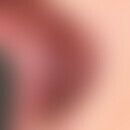Synonym(s)
Atrophodermia linearis Moulin; Linear atrophoderma of Moulin
HistoryThis section has been translated automatically.
Moulin, 1992
DefinitionThis section has been translated automatically.
In the Blaschko lines running, symptomless skin atrophy (atrophodermia) without alteration of specific laboratory parameters.
You might also be interested in
EtiopathogenesisThis section has been translated automatically.
The cause is unknown. Somatic mutations in the early embryonic phase are discussed. The mutated cell clone migrates and could represent a locus minoris resistentiae in which an unknown manifestation factor later triggers the disease.
ManifestationThis section has been translated automatically.
With children and young adults.
ClinicThis section has been translated automatically.
Multiple skin lesions, up to 5 cm in diameter, partly round or oval, partly confluent, brownish-livid, sunken skin lesions. No induration. No focal signs of inflammation. Arrangement along the Blaschko lines.
HistologyThis section has been translated automatically.
Basal hyperpigmentation of the epidermis, ballooned keratinocytes, perivascularly increased lymphocytes in the upper dermis. No inflammatory cells or inflammatory infiltrates, no melanophages; collagenous and elastic tissue of the dermis inconspicuous.
Direct ImmunofluorescenceThis section has been translated automatically.
Deposition of IgG, IgA and IgM in the dermis (probably unspecific pattern).
Differential diagnosisThis section has been translated automatically.
TherapyThis section has been translated automatically.
No effective therapy known to date. Frequent improvement of the untreated course over several years.
Therapies used but unsuccessful: glucocorticoids, penicillin, bathing PUVA. Successes with potassium aminobenzoate (Potaba) have been described in individual case reports.
Progression/forecastThis section has been translated automatically.
All in all a favourable prognosis but cosmetically disturbing.
Note(s)This section has been translated automatically.
If skin changes make one think of a morphea, but follow the Blaschko lines, there is an atrophodermia linearis.
LiteratureThis section has been translated automatically.
- Baumann et al (1994) Atrophodermia linearis Moulin. A new disease picture, following the Blaschko Lines. Dermatology 45: 231-236
- Gansz B et al (2003) Linear asymptomatic skin atrophies in a 14-year-old girl. JDDG 1: 319
- Miteva L et al. (2002) An unusual manifestation of linear atrophoderma of Moulin. Acta Derm Venereol 82: 479-480
- Moulin G et al. (1992) Acquired atrophic pigmented band-like lesions following Blaschko's lines. Ann Dermatol Venereol 119: 729-736
- Rompel R et al (2000) Linear atrophoderma of Moulin. Eur J Dermatol 10: 611-613
Zahedi Niaki O et al. (2015) Linear atrophoderma of Moulin: an underrecognized entity. Pediatr Rheumatol Online J 13:39.
Disclaimer
Please ask your physician for a reliable diagnosis. This website is only meant as a reference.





